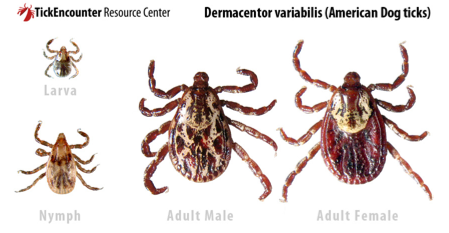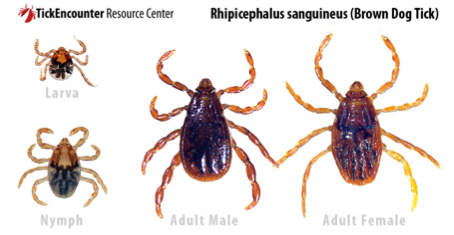
September 2020
Rocky Mountain Spotted Fever
By Dr. Sasha Thomason

|
Rocky Mountain Spotted Fever (RMSF) is caused by the organism Rickettsia rickettsii and is known to infect both dogs and people throughout the United States. Rickettsia spp. are obligate intracellular, gram-negative bacteria; members of this group are divided into the Spotted Fever Group or the Typhus Group.
RMSF is a member of the Spotted Fever Group. There are currently over 20 different species of Rickettsia that have been identified as belonging to this group, and they all cause extensive cross-reactivity on available serologic tests. Because of this, it is difficult to definitively determine which Rickettsia spp. is causing disease in an animal, so RMSF has become known as Spotted Fever Group rickettsiosis.
Rickettsia within the Spotted Fever Group are vector-borne and are transmitted primarily by ticks. In Kansas, the main tick vector is the American dog tick. (Figure 1) It is possible that the brown dog tick could also transmit the disease as it is a known RMSF vector in other parts of the country. (Figure 2.)

|
Depending on the infecting Rickettsia sp., disease symptoms can be mild to severe. RMSF tends to cause a more severe illness than its counterparts; and symptoms include fever, gait abnormalities, lymphadenopathy, edema, hyperemic skin lesions, petechial or ecchymotic hemorrhages, and possibly bleeding disorders. Neurologic symptoms have also been described. The incubation period ranges from two to 14 days. However, a fever commonly occurs within two to three days after tick attachment.
DIAGNOSTIC TESTS:
- Complete Blood Count (CP-10) – Thrombocytopenia is commonly seen but is usually mild (at or above 75,000/uL but lower trends have been reported).
- Serologic Tests – Rickettsia rickettsii Antibody Endpoint Titer IFA (SIF-1040)
- A four-fold increase in titer between acute and convalescent samples taken 10-14 days apart is diagnostic.
- A single high titer (1:1024 or higher) with appropriate clinical signs strongly suggests active infection when titer is taken one week or more after onset of symptoms.
- PCR – Rickettsia rickettsii PCR (MDL-3570)
- A positive result is diagnostic.
TREATMENT:
Doxycycline therapy for two to three weeks is the recommended treatment. Do not delay treatment while waiting on diagnostic test results; an increase in morbidity and mortality has been associated with delaying doxycycline therapy. Tick bite prevention with topical or systemic tick-control treatments is the best preventative treatment.
PUBLIC HEALTH CONCERNS:
Since cases of RMSF in dogs can serve as a sentinel for human cases, it is important to receive a definitive diagnosis, even if the dog is responding to treatment. In recent outbreaks, dogs became ill in the community or household prior to people becoming sick from RMSF. Ticks found on pets should be carefully removed. Information detailing the proper way to remove a tick is shown on the CDC website here: https://www.cdc.gov/ticks/removing_a_tick.html
References:
- Greene CE, Kidd L, Breitschwerdt EB. Rocky Mountain spotted fevers, cat-flea typhus-like Illness, rickettsialpox, and typhus. In: Greene, CE. Infectious diseases of the dog and cat. 4th ed. St. Louis, Mo.: Elsevier/Saunders, 2012. Print.
- Spickler, Anna Rovid. 2012. Spotted Fevers. Retrieved from http://www.cfsph.iastate.edu/DiseaseInfo/factsheets.php.
- Levin ML, Killmaster LF, Zemtsova GE, Ritter JM, Langham G. Clinical presentation, convalescence, and relapse of Rocky Mountain spotted fever in dogs experimentally infected via tick bite. PLoS One. 2014;9(12):e115105. Published 2014 Dec 26. doi:10.1371/journal.pone.0115105
Sasha Thomason, DVM is the Section Head for Accessioning at the Kansas State Veterinary Diagnostic Laboratory.